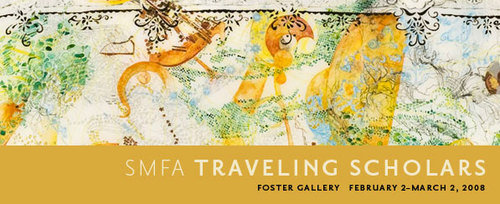Two exhibitions
dal 1/2/2008 al 1/11/2008
Segnalato da
1/2/2008
Two exhibitions
Museum of Fine Arts MFA, Boston
Kufic Korans, on display in the Islamic Corridor, features a broad range of visual cultures, from Egypt to Iran, united by an appreciation for beautiful Arabic text. The annual exhibition of work by recipients of the Traveling Scholarship Awards presents works of 3 Museum School alumni and 3 Fifth Year students.

Kufic Korans: Calligraphy in the World of Islam
“Kufic Korans,” on display in the Islamic Corridor, features a broad range of visual cultures, from Egypt to Iran, united by an appreciation for beautiful Arabic text. Calligraphy serves many purposes in Islamic art, from conveying meaning to acting as decoration, and its importance began in the early days of Islam, when Muslims believe that God first revealed the Koran to Muhammad. The Koran is the holy text and foundation of Islam, and skilled calligraphers throughout centuries have strived to make the text itself beautiful.
All the objects in this exhibition feature an angular style of Arabic calligraphy dubbed Kufic, considered to have originated from Kufa, a city in modern Iraq. Today the term “Kufic” is used by calligraphers and scholars alike to describe a wide range of angular Arabic script. Early Kufic Koran manuscripts, enhanced by gold and silver illumination, were commissioned by powerful Muslim rulers and large mosques. This angular and horizontal style also lent itself well to architectural inscriptions on monuments. Later, the angular style of script would be revived by calligraphers and artisans looking back to the austerity of the past and exploring Kufic’s potential to become more ornamental and abstract. Even in the 21st century, international corporations and local businesses in the Islamic world often utilize Kufic for their designs.
..........................
SMFA Traveling Scholars
till Sunday, March 2, 2008
The annual exhibition of work by recipients of the prestigious Traveling Scholarship Awards—three Museum School alumni and three Fifth Year students—is always an intriguing selection of challenging, original work by emerging contemporary artists. Modes of communication, intersection of opposing forces, ecological concerns, pop culture, and the human body are among the themes in this year’s work. The medium of choice ranges from painting (Laurel Sparks and Leslie Hall) and photography (Bill Durgin), to gigantic drawings (Elizabeth Wallace), installations (Mathew Freeman and Will Pappenheimer), and performance (Leslie Hall).
Scholars in this year’s group traveled to Europe and to Australia, India, and within the United States. Their travels, in some cases, inform their work (Will Pappenheimer’s study of Australian birds, Laurel Sparks's study of Venetian glass chandeliers), while in others, they remain internalized. As a whole, “SMFA Traveling Scholars,” on view in the Foster Gallery, well represents the Museum School’s philosophy of nurturing individual development as it encourages artists to explore new paths and engage new audiences.
Museum of Fine Arts
Avenue of the Arts 465 Huntington Avenue - Boston



